P55 Extreme Overclockers: Check your sockets!
by Rajinder Gill on October 15, 2009 12:01 AM EST- Posted in
- Motherboards
We start with a picture.
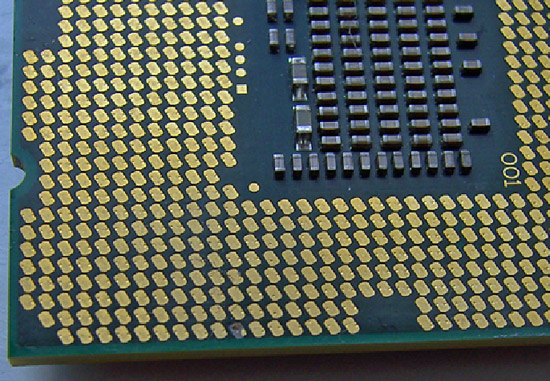
The picture above is after our Core i7 870 (LGA-1156) processor was overclocked up to 5.19GHz using our cascade with a -102° Celsius evaporator head temperature under full-load. Processor VCC power draw at these frequencies is around 160W (this is possible only due to subzero cooling), as measured with a clamp meter installed at the 12V EPS power lead. Study the pictures closely and you should notice something peculiar. Keep in mind it comes from a CPU installed in the same type of socket from a particular manufacturer.
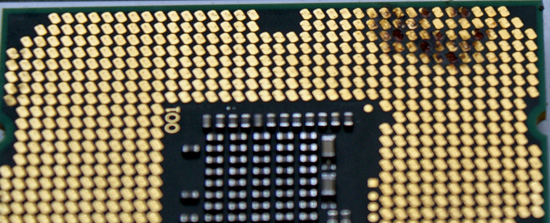
What happens after several extreme benchmark runs...
If you noticed something weird in the pictures then you understand the title of our article. We have what seems to be a potentially serious issue with proper socket loading on several P55-based motherboards when overclocking to the limit. We are of course not the only ones experiencing the problem as several of our overclocking peers have run into the same problem.
Normally we do not worry too much about mishaps during extreme overclocking testing as they are typically caused by factors outside of the supplier’s control. The overriding concern is that we have damaged every motherboard in our possession for the P55 overclocking (extreme) shootout as well as two very expensive i7/870 processors. These problems are the cause of a single component and are repeatable. As such, we thought we would provide details on current problems and will provide an update once all of the motherboard manufacturers affected have had a chance to properly respond.
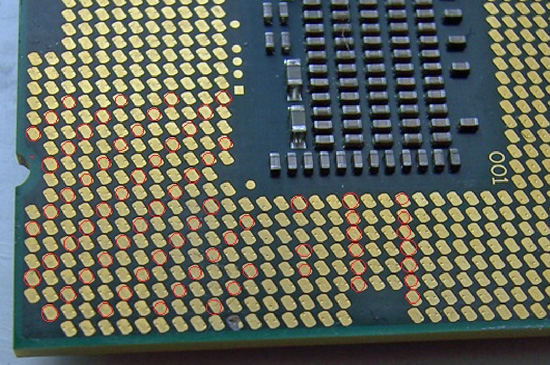
We draw your attention to the fact that the processor shown in this pictures exhibits signs of insufficient pin-to-pad contact (little to no contact) in what is a rather reproducible pattern with Foxconn manufactured 1156 sockets. As soon as an end-user mounts a CPU in a socket and latches the clamp mechanism, each pin should leave a notable mark on the associated pad.
We've marked locations where this does not seem to have happened, showing what appears to be a significant reduction in the number of VCC/VSS pins for proper power delivery, and certainly not at the right load line resistance. Damage resulting from highly overclocked use in these types of situations is not solely limited to the processor; let’s take a look at what happened to some of the motherboards in which these CPU were seated.
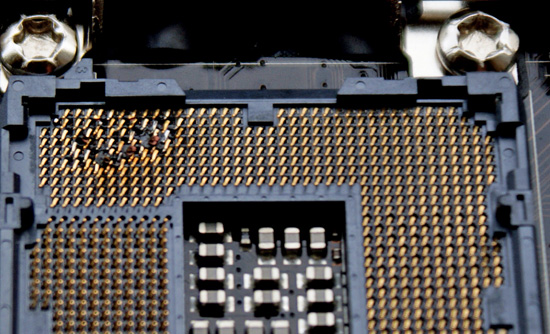
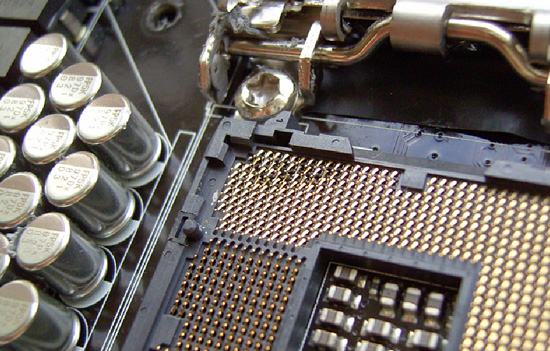
When Intel publishes socket specifications and design tolerances, it's up to component manufacturers to strictly adhere to them when designing, manufacturing, testing and ultimately selling their "compliant" components. Of course, that's not to say Intel could not have goofed when releasing their specification, leaving out a crucial tolerance or such. It could happen, but not likely. For the time being, let's assume that's not the case; seeing as how processors installed in sockets built by other companies have exhibited no such issue in testing to date.
At first glance, one might be inclined to think LGA-1156 based processors are intolerant of high-end overclocking, almost as if by design. This is correct to some extent; a quick glance at Intel’s white papers for socket 1156 CPU’s reveals that there are around 175 pads for VCC compared to over 250 for socket 1366 CPU’s. This means socket 1156 has around 66% of the current capacity of socket 1366, the caveat being that when overclocked, processors from both platforms draw similar levels of current.
When overclocked above 4GHz, processors from both platforms will draw around 15-16 amps via the EPS 12V rail to VCC, VTT and some of the other sub –system power rails under full 8 thread load from the Intel burn test (Linx). Assuming 85% PWM efficiency, we’re looking at power draw in the region of 130-140w to VCC on both platforms. The facts point toward tighter current handling tolerances for socket 1156 when compared to socket 1366, especially when it comes to non-connection of VCC/VSS power delivery pins.
Fortunately, we think we've been able to isolate pin to pad contact issues to one particular brand of parts. Physical inspection and end-user reports all but confirm the issues only affects sockets manufactured by Foxconn at this time. The only known alternative sockets in the wild are made by LOTES or Tyco AMP. We happen to have a couple of boards from EVGA using the LOTES/Tyco AMP sockets and MSI/DFI using the LOTES socket design, and thus far those boards have been issue free given highly similar operating conditions. In fact, we’ve managed to push our LGA-1156 processors further in heavy load tests on boards made using LOTES/Tyco AMP sockets than those made with sockets from Foxconn; something we’re not putting down solely to coincidence.
So far, EVGA is the only company we know that uses sockets exclusively from LOTES on their top-tier P55 boards - for example, the EVGA P55 Classified 200, model E659. This by the way may be the onus behind the decision to market the board’s “300% More Gold Content” socket statement as a purchasing option point. If you find yourself shopping for an EVGA P55 FTW, model E657, you've got a 50/50 chance of buying one with a Tyco AMP socket design (using a LOTES backplate), as opposed to one made solely with Foxconn's, the same goes for MSI and DFI who have batches of boards in the retail channel using LOTES sockets (although we're not entirely sure on socket specifics at this point). DFI told us earlier they have dropped usage of the Foxconn sockets completely until further notice. We hear the LOTES and Tyco AMP sockets are in short supply, which is probably why Foxconn's been able to fill the void in the market with what we believe to be a lower quality alternative for the extreme overclocker.
We took one of our damaged CPU’s and inserted it into one of the EVGA (LOTES/Tyco AMP) boards and took a few pics to show contact scoring and a side by side compare to the original Foxconn socket indents.
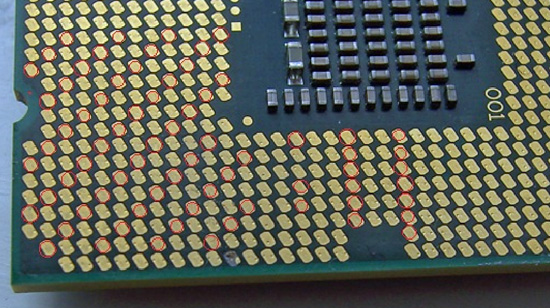
Foxconn 1156 Socket Installation
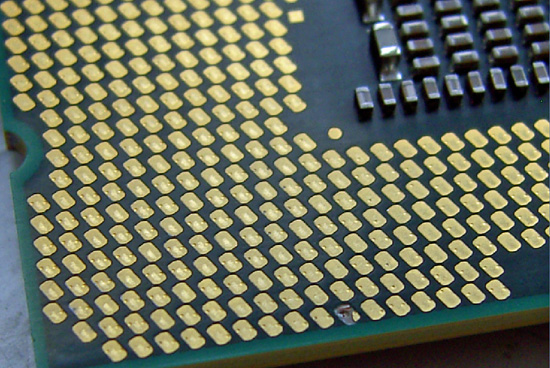
Tyco AMP / LOTES 1156 Socket Installation
Note how from a variety of angles certain pads show no evidence of contact from a Foxconn pin at all. Both the Tyco AMP and LOTES sockets have a larger pin/pad contact surface area leaving a slight scuff mark in the central area of each pad. In light of this, what we will say is that if you’re thinking of doing extreme overclocking on a board built using Foxconn's socket 1156, think again. Or, at least check your CPU for evidence of proper pin-to-pad contact.
We have not had any problems with air or water cooling overclocking up to 4.3GHz, although we do have a i5/750 that has developed a few dark pads after a thousand hours or so of constant overclocking. However, none of the boards have developed pin problems so we feel very safe in saying that any problems will probably occur only in extreme overclocking scenarios.
We also realize that partial responsibility for some of the less than acceptable CPU installations may be in fact due user installation errors. However, if users are screwing this up by doing nothing different than what they've always done when it comes to handling and installing LGA-type processors, then it's hard for us to find fault with the installer. Be aware of this situation and study the pin imprint on the CPU pads and make sure you have good contact on the VCC/VSS power delivery pads before pushing the system too hard.
















273 Comments
View All Comments
JDD - Sunday, October 18, 2009 - link
How about these guys at anandtech don't they have a chip they havent blown up yet?Rajinder Gill - Sunday, October 18, 2009 - link
yeah the pricks are from factory CPU's. The Foxconn head contact should leave a small scuff mark on every pad, but it does no seem this always happens due to incorrect loading.Rajinder Gill - Sunday, October 18, 2009 - link
http://img27.imageshack.us/img27/5551/cpumelt.jpg">http://img27.imageshack.us/img27/5551/cpumelt.jpganother one, damage not so severe on this one, but getting close.
nofumble62 - Saturday, October 17, 2009 - link
Land of opportunityDahakaCL - Saturday, October 17, 2009 - link
Hi there again.I read a lot and my MIIIF have this problem, i don't want to keep this MB so i decided sell it and get EVGA SLI 132-LF-E655-KR, if anyone ( again xD ) have some information about this model please let me know!!.
I have a F1 Extreme POT from Kingpin and i don't wanna blow up this plataform lol.
Thanks. Regards from Chile
CW1d - Saturday, October 17, 2009 - link
I am fascinated to read that there are people who are willing to accept less than the original design specifications as long as the product works. Of course the definition of what 'works' means is of absent. In this particular situation we have one manufacturer who was able to produce a socket that satisfied the Intel design requirements and one who appears to not have been able to satisfy those requirements. We also seem to have customers who are happy to shell out their money (or maybe theirs parents money) for products that are not up to spec. With the rational 'As long as those products work' - well at least for the short term. I wonder if those same consumers would be as cavalier about buying a automobile with a braking system that was not quite up to spec but worked under normal and fair usage, namely that no one exceeds the speed limit or has ever had an extra passenger in the car than the recommended total number of passengers. So if the brakes were to fail because their was one passenger to many or the vehicle was traveling a few miles above the speed limit then of course the car company that produced the brakes was not responsible, rather it is the user who is to blame. Sound familiar? Somehow I think that notion is a bad one.The argument that all is fine as long as it 'works' within stock usage holds no water. Even the manufactures themselves acknowledge that with their preprogrammed profiles to over clock a CPU. They endorse the practice of wringing extra performance above the stock parameters with the over-clocking software included with the drivers, and very pleased I am that they do so and long my they continue. So let us just put aside that notion of acceptable usage AKA stock only and move on shall we. The issue is not really about how the product is used. The over-clockers noticed it first. Yes. Just as racing drivers have pioneered many of the safety features we take as standard in our daily runabout cars. (Yes I am in the automobile industry so forgive the car analogies)
Why should the consumer accept second best? Why should the consumer accept a product that can potentially damage their other components? I see no real or compelling reason to do so. To check my own set up I pulled my CPU that is running at 'stock' from my Gigabyte UD3R board and checked to see the indentation on the pads. Yip I too have a similar pattern of absent indents. So that means that my stock set up with the stock Intel cooler installed corrects as per the instructions that come with it is not making contact correctly between all pins and all pads. That does not make me happy.
What the way forward is, well I have no idea. Adding a shim under the latch will not be a good idea. The very same over-clockers who first noticed this issue, will certainly tell you that over pressure on the fragile pins is not a good idea. So I guess for folks like me who need to use their machine for work and can not afford to buy another system just yet, we will have to wait and see.
ClagMaster - Sunday, October 18, 2009 - link
Last night I was debating whether to spend some of my valuable time replying to your post. You accuse me of being complacent and unthinking. No, I am not complacent. It’s just the 30 year experienced engineer within me having a questioning attitude over this article and an elderly head shaking over the fear-ridden opinions and panicked responses of many of its bloggers.Here’s a fact:
Last night I opened a box containing a brand new Q6600 processor. I took a magnifying glass to the CPU pads and found there were dimple marks on the CPU. Also some of these pads did not have these dimple marks in certain patterns. Since this is a processor from an unopened box from the factory, I must conclude these dimple marks are from the test equipment and have no bearing at all on how well the LGA 775 socket engages its pins. None what-so-ever. Understand? Such an assertion is bogus. The same is true for the i5/i7 LGA 1156 CPU pads. These dimples are from factory test equipment and NOT from motherboard Foxconn, LOTES or whatever LGA 1156 sockets. Some dimples are missing probably because these pads most likely not necessary for testing the processor.
I also took a magnifying glass to a LGA775 socket pins of a motherboard. The pins are squared at the end. No pinheads. I strongly suspect the LGA 1156 pins are also squared at the ends too.
Here’s another fact:
Intel and AMD test their CPUs for performance and reliability. The performance of these CPU’s falls under a bell curve and they are binned according to market objectives. If you bought an i5, you probably have a second-rate core. It operates at lower frequencies before failing. You have no choice in this matter except to spend the extra money for the first-rate core.
Here’s an observation:
The LGA 775 and LGA 1156 technologies are identical and I doubt Foxconn and other manufacturers have changed their manufacturing processes for LGA 1156. They have been making LGA-775 for five years and have sufficiently perfected the process to provide acceptable sockets. LGA 1156 is an extension of LGA 775. The pin-to-pin length variability ought to be the same. Foxconn may have changed the alloy or plating of the pins. What is different for sure is the clamping mechanism. The clamp mechanism may not provide as much compressive force to the CPU and the pins, though all are in contact with the pads, to provide a minimal gap to avoid arcing under extreme conditions. These are more likely issues.
Here’s another observation:
The failed sockets and pads occurred during extreme overclocking where maximum voltages and currents are experienced. These maximum currents and voltages are well over design limits established by Intel. The damage is from arcing and melted pins from too much current. Overclockers deliberately abuse their processors until a limit is reached. In this case the obvious limit of the i5/i7 processors is the ability of the LGA 1156 socket to conduct the necessary electrical energy. That the LGA 1156 failed as it did during these extreme conditions concerns me not. And my posterior bleeds for those overclockers who belly-ache about these mishaps which are of their own doing.
Here’s a considered opinion:
Extrapolating performance of Foxconn LGA 1156 sockets from extreme overclocking conditions (>160W) to normal operating conditions (<95W) of operation is totally bogus. During operation within design TDP, arcing that burns CPU pads will not occur and current is not sufficient to melt and distort pins. Arcing is a threshold process. Gap voltage has to be sufficiently high at localized points within the gap to ionize the air within the gap. Once started, more ionization occurs, plasmas are formed and burning happens. This does not happen during operation at normal operating voltages and currents.
As far as I am concerned, the Foxconn LGA 1156 sockets are adequate for normal operating voltages and current. This socket functions within the design specification. And this has been borne out through the benchmark tests of Gigabyte, Asus and MSI P55 motherboards at Anandteh.
To return an i5/i7 CPU and a P55 motherboard because of fears borne from this bogus extrapolation is irresponsable and not an acceptable reason. The CPU and motherboard had not failed you and is not likely to fail you if operated it as Intel intended it.
This is mindless, fear-ridden behavior.
Conclusion:
This article by Rajinder Gill is poorly conceived and uses information that is (in my opinion) bogus. What is bogus are the dimple marks on the i5/i7 processors which are no indication of how well motherboard LGA 1156 pins engage the CPU pads. I would have liked to have seen more relevant information on pin alloys and bracket compression forces in this article between Foxconn and LOTES sockets.
The failures of Foxconn sockets during extreme overclocking cannot be extrapolated to operation at normal voltages and currents as many fear-ridden bloggers have attempted to do.
This contents of this article will provoke ill considered actions of owners to return perfectly-good i5/i7 CPUs and motherboards to vendors. These motherboards should provide years of service if operated to normal voltages and currents.
chrnochime - Monday, October 19, 2009 - link
So CW1d is the same person as Clagmaster?Impressive background, but then again I never refuted your expertise in the auto field.
Am I missing something here, or what you said basically confirmed what I've been stating in the first place, that what's happening at extreme OC cannot be used to extrapolate behavior of the same socket at normal operating frequency? Then again, this statement goes both ways, that even though it does not correctly lead to induction of socket failure at any frequency beside OC, it also does not eliminate the possibility of the failure.
I don't have time to type out something as carefully worded and detailed as your post was, so you'll have to settle for hastily typed response.
I apologize if that first post came off as an attack of your character.
ClagMaster - Monday, October 19, 2009 - link
Accepted :)chrnochime - Monday, October 19, 2009 - link
I didn't write that in the first post. nvm. Not paying attention AT ALL.Guess it's up to the reviewers and websites to clear this up. I do want to finally buy a quad-core though.